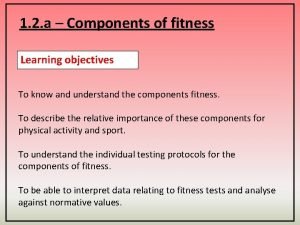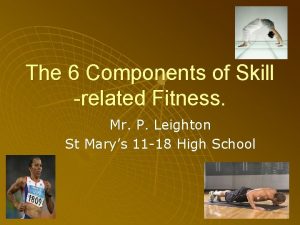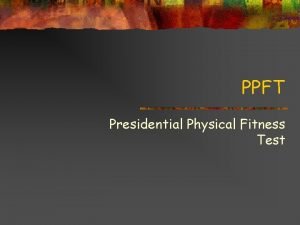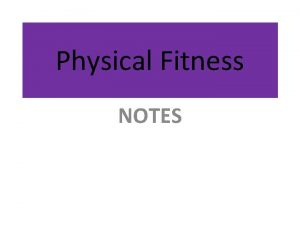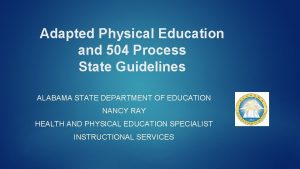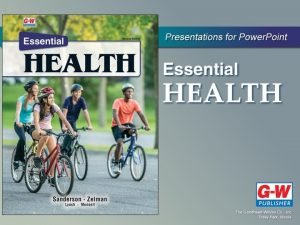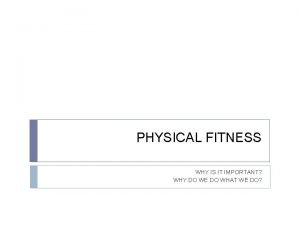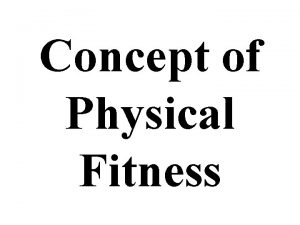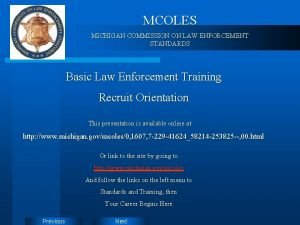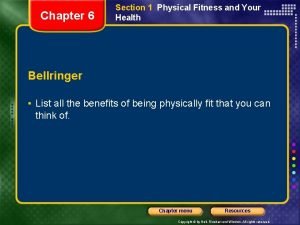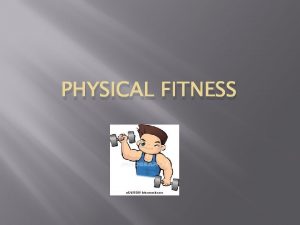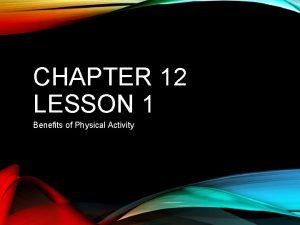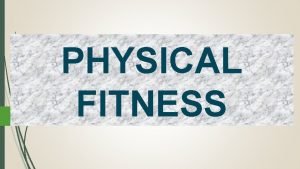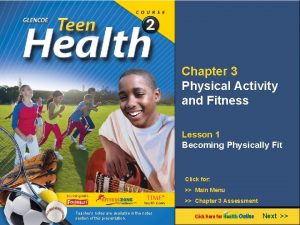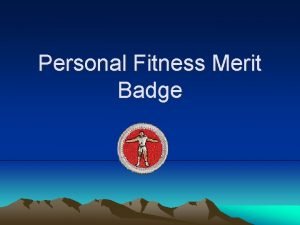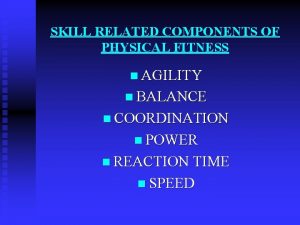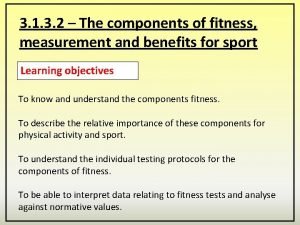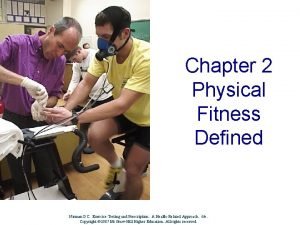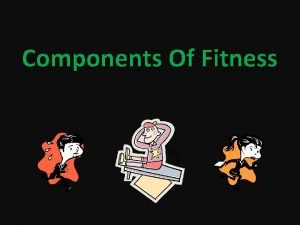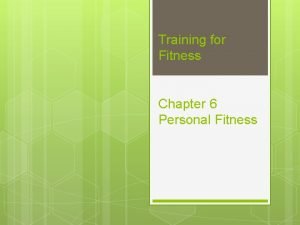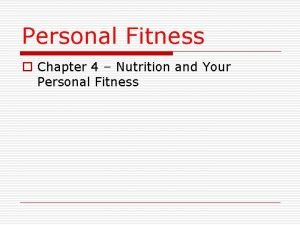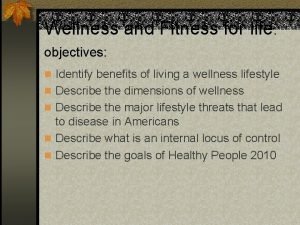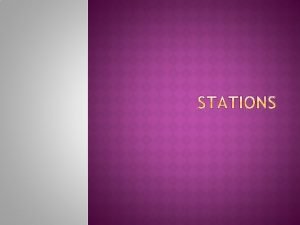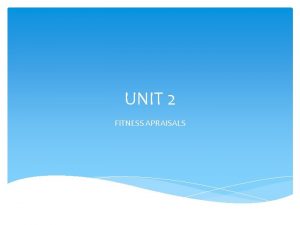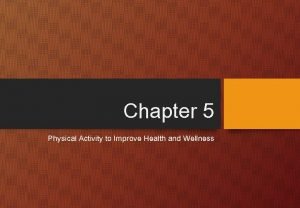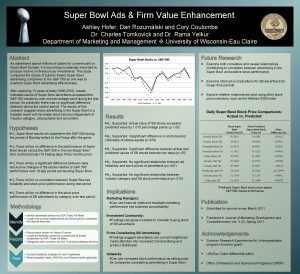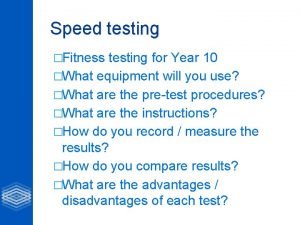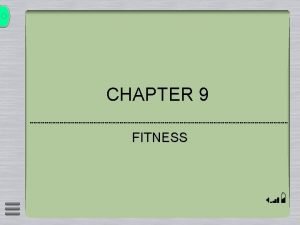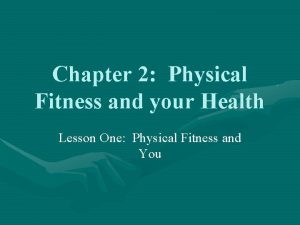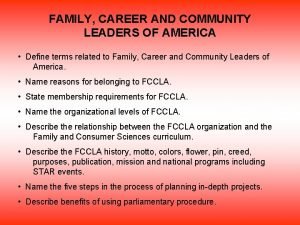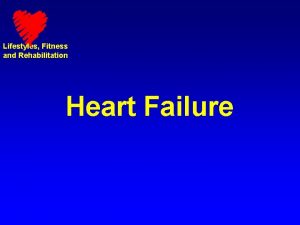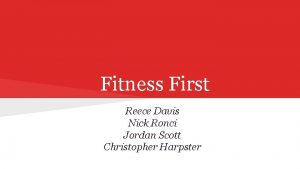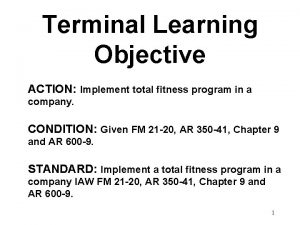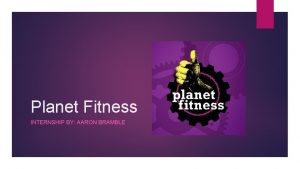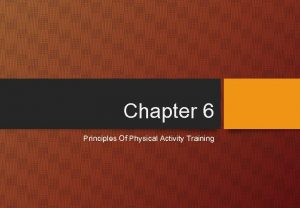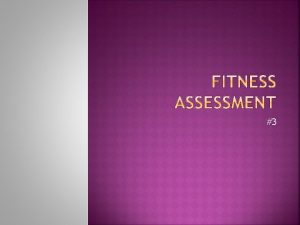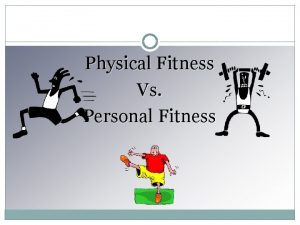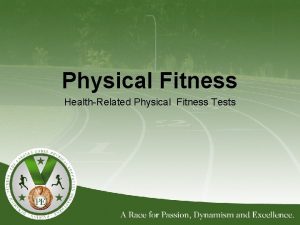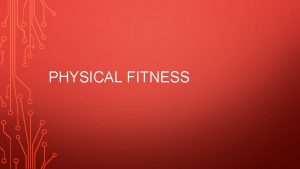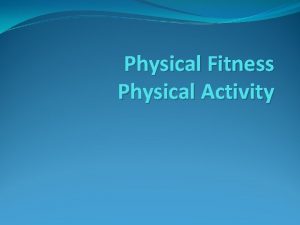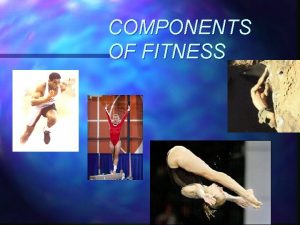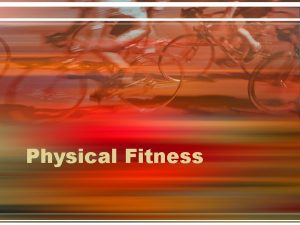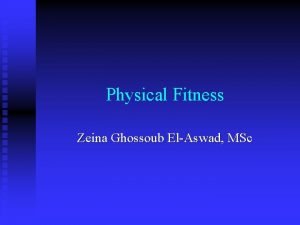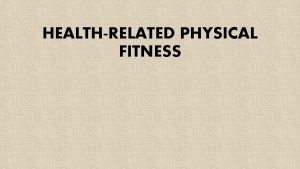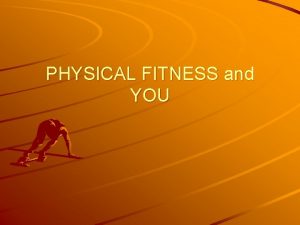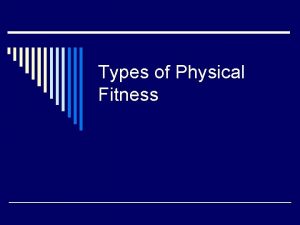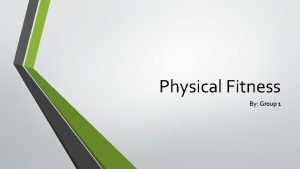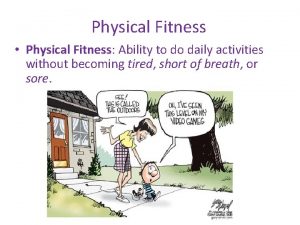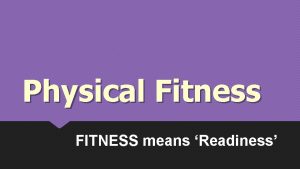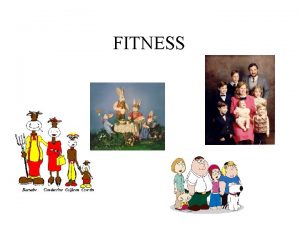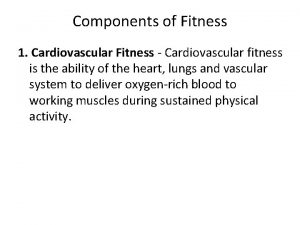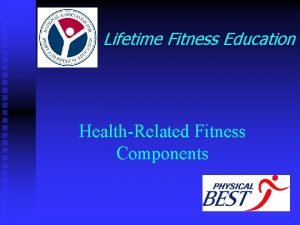PHYSICAL FITNESS WHAT IS PHYSICAL FITNESS Physical fitness


























































- Slides: 58

PHYSICAL FITNESS

WHAT IS PHYSICAL FITNESS? • Physical fitness, in general terms, is a person’s ability to meet the physical stresses and demands of a variety of physical activities efficiently and effectively. • Example; work at home and in the workplace, leisure-time pursuits, and for sports.

• The physical stresses and demands of daily living range, for example, from sitting, eating, standing, to the extreme physical demands of shovelling after a major snowstorm, marathon running, and firefighting • Each of these activities requires varying degrees of cardiorespiratory endurance (CRE), muscular strength, muscular endurance, and flexibility to perform it well

• Many people are faced with demanding tasks, such as lifting/carrying heavy objects, building, which can over-stress the body if it does not have an adequate level of physical fitness. Adequate preparation for these periodic tasks is essential to help minimize the risks of heart attack, stroke, and back injury.

PHYSICAL FITNESS DEFINITIONS • “A set of attributes that people have or achieve that relate to their ability to perform physical activity” (Howley and Franks). • “The ability to perform moderate to vigorous levels of physical activity without undue fatigue and the capability of maintaining such ability throughout life” (American College of Sports Medicine).

TWO CATEGORIES OF PHYSICAL FITNESS COMPONENTS • Health-related fitness components • • • � cardiorespiratory endurance � muscular strength � muscular endurance � flexibility � body composition • Skill-related fitness components • � agility • � balance • � coordination • � speed • � power • � reaction time

HEALTH-RELATED FITNESS COMPONENTS • Health-related fitness components not only help the body to perform more efficiently, but also help prevent disease and improve overall health and well-being

FIRST…MAXIMUM HEART RATE (MHR) • Easiest formula to get an estimate of what your maximal heart rate is • Only an estimate, not exact (actual MHR is likely less, and varies depending on gender, age, ethnicity, level of physical fitness, etc. ) • MHR = 220 – AGE • https: //www. youtube. com/watch? v=ZIs_NEk. Jbno

ACTIVITY • Calculate resting heart rate • Perform to failure (as long as you can), either isolated dumb bell hold, wall sit, or tricep dips. • With a partner, calculate heart rate • Count for 15 seconds and x 4 OR count for 10 seconds and x 6

FITT PRINCIPLE Frequency (How Often will you workout. For example, 3 x/week, 4 x/week, 5 x/week ) Intensity (How Hard of a workout. For example, Low, Moderate or High) Type (What Kind of workout. For example, Zumba, Weights, Swimming, Aerobic, etc) Time (How Long can you exercise each session)

HIIT (HIGH INTENSITY INTERVAL TRAINING) • • Best form of cardio to burn fat, and build lean muscle mass • HIIT can be used both anaerobically (in the gym with weights) and aerobically with cardio. • You burn more TOTAL calories than if doing slow steady exercise (like going for a long jog) • You increase your metabolism and burn more calories for up to 24 hours after interval training, whereas going for a jog burns almost NO calories after. What is HIIT? HIIT is alternating between very intense bouts of exercise and low intensity exercise (For example, sprinting for 10 seconds, walking for 45 seconds, alternating back and forth 10 times.

HIIT WORKOUTS YOU CAN DO - Bike 5 min steady pace on lowest level 30 sec at 100 rpm on difficult level 1 min at 70 rpm on easy level Repeat 10 x Cool Down with 5 min slow on easy level Sprinting -light jog for 5 min -Sprint 10 sec, walk 30 sec -Repeat 12 x -Cool Down with 5 min of walking Swimming -Swim 5 min of laps in the stroke you plan on using -Sprint (swimming) 1 lap, rest 1 min -Repeat 12 x -Cooldown: Swim a light 5 min ***Only do under supervision, if you’re a strong swimmer, and don’t take risks getting tired

CARDIORESPIRATORY ENDURANCE (CRE) • is the ability of the cardiovascular system (heart, blood vessels) and respiratory system (lungs, air passages) to deliver oxygen and other nutrients to the working muscles and to remove wastes. Tests that involve running (e. g. , 20 m shuttle run test), can be used to measure this fitness component. • Aerobic =Longer lasting (marathon) – over 1 minute. Using oxygen • Anaerobic = short lasting, high intensity (100 m sprint) – under 1 minute. Using only oxygen you have stored.

MUSCULAR STRENGTH • � Muscular strength is the ability of a muscle, or a group of muscles, to exert force for a brief period of time. Strength of different muscles can be measured by having a person perform weightlifting exercises and determining the maximum amount of weight the person can lift.

• � Light activities are physical activities that involve large muscle groups. While engaging in light activities, people begin to notice their breathing, but they can still talk fairly easily. • � Moderate activities are physical activities that cause breathing and heart rate to increase. People engaging in moderate activities can hear themselves breathe, but they can still talk. • � Vigorous activities are physical activities that cause breathing and heart rate to increase to a higher level, making it difficult to talk.

MUSCULAR ENDURANCE • Muscular endurance is the ability of a muscle, or a group of muscles, to sustain repeated contractions or to continue applying force against a fixed object. Push-ups and curl-ups are often used to test muscular endurance. The person’s endurance is expressed as the number of repetitions completed without stopping for a set period of time (often one minute). Activity

FLEXIBILITY • Flexibility is the ability to move joints through their full range of motion. The sit-and-reach test is a good measure of flexibility of the lower back and the backs of the upper legs (hamstrings). • A person’s flexibility is usually expressed in how far a joint can be moved or the degrees through which a joint can be moved.

BODY COMPOSITION • Body composition refers to the makeup of the body in terms of lean mass (muscle, bone, vital tissue, and organs) and fat mass. • Good body composition has strong bones, adequate skeletal muscle size, a strong heart, and a low amount of fat mass. Regular physical activity and exercise will help decrease body fat and increase or maintain muscle mass, increase bone mass, and improve heart function.

PRINCIPLES OF FITNESS DEVELOPMENT • Specificity • Overload • Reversibility • Progression • Diminishing Returns • Individual Differences

SPECIFICITY • �The type of training in which individuals engage should be directed specifically at improving their abilities in life. Therefore, choose the right kind of activities to improve each physical fitness component, and the right combination of physical fitness components to help in activities of daily living. Strength training results in increases in strength for the muscles being exercised but does little to improve cardiorespiratory endurance.

OVERLOAD • If a person works often (frequency) enough, hard (intensity) enough, and long (duration) enough to load the body above its resting level, physical fitness will improve. If this is done regularly over a period of time, the body will gradually adapt to the increase in demands. The term overload does not refer to the idea that one needs to overexert or exert at high intensities to obtain gains in fitness; it simply means that one needs to load the body more than it is usually accustomed to.

REVERSABILITY • Physical fitness or the effects of a physical activity program or an exercise program cannot be stored. If a person stops training for a period of time (three to five days, in some cases) a process of detraining will begin.

PROGRESSION • Increasing the frequency, intensity, and/or duration of an activity over periods of time is necessary for continued improvement in physical fitness. Improvements in physical fitness are realized fairly rapidly at the onset of an exercise or training program. The rate of improvement will gradually slow down and level off (adaptation) if an overload is present (meaning that the load is increasing and that there is progress). At high levels of physical fitness it may even be necessary to change the type(s) of exercise(s) being performed

DIMINISHING RETURNS • The fitter a person becomes, the more difficult it is to continue to become fitter at the same rate. Individuals who begin jogging can, over a relatively short time, improve the speed and duration of their runs.

TRAINING FOR MUSCLE MASS • https: //www. youtube. com/watch? v=o 9 z. Cg. Ptsups

TRAIN INTELLIGENTLY • Start with a dynamic warm-up • Use proper technique in training • Eat healthy foods, at the right times

DYNAMIC WARM-UP: PURPOSE • 1: Increase Muscle Temperature: Dynamic stretching means your body is still continuously moving, even while stretching. Given the fact that the purpose of the warm up is to raise your muscles' core temperature, keeping on the move is very beneficial. 5 -10 minutes spent doing static stretching can lead to your muscles' core temperature dropping. As such, your muscles, although stretched, would be less elastic and less powerful • 2. PREVENTS INJURIES! • https: //www. youtube. com/watch? v=t. H 2 Q 5 ab. Ie. Is

• 3. Sport Specific: Dynamic stretching prepares the muscles in a sport specific way. Whereas a static stretches warm up may loosen off the muscles, it has no relevance to what you are actually about to perform. A warm up including dynamic stretching prepares your muscles for the movements they will make in a game situation • 4. Increase Range of Movement: Dynamic stretching helps to improve the range of motion around your joints. This can help reduce the chances of injury, while over time it improve your performance maximum due to the improved movements the increased flexibility in your joints will allow • 5. Enable the Stretch Reflex: This is designed as a protective measure for the muscles, to prevent tearing. The muscle spindle is stretched and the impulse is also immediately received to contract the muscle, protecting it from being pulled forcefully or beyond a normal range. is a pre-programmed response by the body to a stretch stimulus in the muscle. When a muscle spindle is stretched an impulse is immediately sent to the spinal cord and a response to contract the muscle is received.

DYNAMIC WARM-UP: EXERCISES


SPIDERMANS

7 OTHER DYNAMIC WARM-UP EXERCISES: VIDEO • http: //greatist. com/fitness/full-body-dynamic-warm-up

COOL DOWN • Static Stretch • Hold a single stretch 30 -60 sec, repeat 2 -4 x per stretch • A post-activity stretch can help reduce muscle soreness (therefore will be able to exercise again sooner) by lengthening the muscle, removing lactic acid and increasing blood circulation. • Other benefits include increasing the range of motion of joints, as well as improving coordination, body awareness and posture

BREATHING AND MOBILITY EXERCISES • Usually done before a dynamic warm-up or on their own. Mobility exercises can also be done after a dynamic warm-up in preparation for high intensity training, or training that requires significant range of motion • Breathing exercises with mobility exercise promotes range of motion, and help you get further into your stretch.

Static stretch routine YOU can do

PARTNER ACTIVITY • Create a 5 minute dynamic warm up and 5 minute cool down • Each exercise in warm up and cool down should be no longer then 30 seconds • Sport specific

BENCH PRESS 1. Lie back on a flat bench. Using a medium width grip (a grip that creates a 90 -degree angle in the middle of the movement between the forearms and the upper arms), lift the bar from the rack and hold it straight over you with your arms locked. This will be your starting position. Tip: NEVER USE A FALSE GRIP (check next slide) WHEN DOING BENCH PRESS. Always wrap your thumb around the bar and rest the bar in the palm of your hand.

Bench Press Grips GOO D False Grip= BAD

BENCH PRESS CONT’D • 2. From the starting position, breathe in and begin coming down slowly until the bar touches your middle chest. Tip: Your upper arms should be about a 45 degree angle from your body. Visualize ripping the bar in half which will automatically help you with this. • 3. After a brief pause, push the bar back to the starting position as you breathe out. Focus on pushing the bar using your chest muscles. Lock your arms and squeeze your chest in the contracted position at the top of the motion, hold for a second and then start coming down slowly again. Tip: Ideally, lowering the weight should take about twice as long as raising it. • 4. Repeat the movement for the prescribed amount of repetitions. • 5. When you are done, place the bar back in the rack.

OVERHEAD SQUAT 1. Start out by having a barbell in front of you on the floor. Your feet should be wider than shoulder width apart from each other. 2. Bend the knees and use a pronated grip (palms facing you) to grab the barbell. Your hands should be at a wider than shoulder width apart from each other before lifting. Once you are positioned, lift the barbell up until you can rest it on your chest. 3. Move the barbell over and slightly behind your head and make sure your arms are fully extended. Keep your head up at all times and also maintain a straight back. Retract your shoulder blades. This is your starting position. 4. Slowly lower the weight by bending your knees. Tip: Keep your back straight while performing this exercise to avoid any injuries and your arms should remain extended and over your head at all times. 5. Now use your feet and legs to help bring the weight back up to the starting position while exhaling. 6. Repeat for the recommended amount of repetitions.

GOBLET SQUAT 1. Stand holding a light kettlebell by the horns close to your chest. You can also use a dumb bell in this exact same position. This will be your starting position. 2. Squat down between your legs until your hamstrings are on your calves. Keep your chest and head up and your back straight. 3. At the bottom position, pause and use your elbows to push your knees out. Return to the starting position, and repeat for 10 -20 repetitions. https: //www. youtube. com/watch? v=AHE 6 kpog. Q_s

DUMBBELL SQUAT 1. Stand up straight while holding a dumbbell on each hand (palms facing the side of your legs). 2. Position your legs using a shoulder width medium stance with the toes slightly pointed out. Keep your head up at all times as looking down will get you off balance and also maintain a straight back. This will be your starting position. Begin to slowly lower your torso by bending the knees as you maintain a straight posture with the head up. Continue down until your thighs are parallel to the floor 3. Begin to raise your torso as you exhale by pushing the floor with the heel of your foot mainly as you straighten the legs again and go back to the starting position. 4. Repeat for the recommended amount of repetitions

HOW TO LEARN THE SQUAT (THE KING OF ALL EXERCISES) • http: //www. youtube. com/watch? v=1 ZNELZKig. Uk#t=263

ONE-LEGGED DEADLIFT -Develop unilateral strength (i. e. , strength off of one foot in this case) -Strengthens glutes, hamstrings, core, and back

BICEP CURL WITH DUMBBELL Step 1 • Stand up straight with legs shoulder-width apart or sit on a bench. If you're sitting on a bench, make sure your head, shoulders and butt are in contact with the bench with your feet firmly on the ground. Step 2 • Hold a dumbbell in each hand. Make sure your thumbs are curled around the grips. Hold the dumbbells by your sides, palms facing forward. Keep your back straight and shoulders rolled back and down.

Step 3 • Bend your elbows and slowly bring the dumbbells up to your chest while breathing out. Keep your elbows by your sides and don’t arch your back. Make sure your wrists are in line with your elbows and keep your shoulders straight. Step 4 • Breathe in as you lower the dumbbells away from your chest back to the starting position. Maintain a slow and controlled movement as you straighten your elbows. That's one rep. Aim for two to three sets of 8 to 12 repetitions (lifts). Increase the weight when the repetitions become easier to perform. Step 5 • You can work the biceps more by holding the dumbbells at the starting position with your palms facing in toward your sides. As you bring the dumbbells up, twist your wrist and forearm up so the dumbbells ends facing your chest. As you bring the dumbbells down, twist your wrists and forearms back toward your sides as your arms come to rest. • https: //www. youtube. com/watch? v=E 6 VMg 0 E 9 Jp. E

TRICEP EXTENSION WITH DUMBBELLS • To begin, stand up with a dumbbell held by both hands. Your feet should be about shoulder width apart from each other. Slowly use both hands to grab the dumbbell and lift it over your head until both arms are fully extended. • The resistance should be resting in the palms of your hands with your thumbs around it. The palm of the hands should be facing up towards the ceiling. This will be your starting position.

TRICEPS CONT’D • Keeping your upper arms close to your head with elbows in and perpendicular to the floor, lower the resistance in a semicircular motion behind your head until your forearms touch your biceps. Tip: The upper arms should remain stationary and only the forearms should move. Breathe in as you perform this step. • Go back to the starting position by using the triceps to raise the dumbbell. Breathe out as you perform this step. • Repeat for the recommended amount of repetitions. • https: //www. youtube. com/watch? v=8 n. WNy. Qa. Eba. M

SHOULDERS – BARBELL SHOULDER PRESS • Sit on a bench with back support in a squat rack. Position a barbell at a height that is just above your head. Grab the barbell with a pronated grip (palms facing forward). • Once you pick up the barbell with the correct grip width, lift the bar up over your head by locking your arms. Hold at about shoulder level and slightly in front of your head. This is your starting position. • • Lower the bar down to the shoulders slowly as you inhale. Lift the bar back up to the starting position as you exhale. Repeat for the recommended amount of repetitions. http: //www. bodybuilding. com/exercises/detail/view/name/barbell-shoulder-press

BACK EXERCISE – SEATED CABLE ROW • To get into the starting position, first sit down on the machine and place your feet on the front platform or crossbar provided making sure that your knees are slightly bent and not locked. • • Lean over as you keep the natural alignment of your back and grab the V-bar handles. • Keeping the torso stationary, pull the handles back towards your torso while keeping the arms close to it until you touch the abdominals. Breathe out as you perform that movement. At that point you should be squeezing your back muscles hard. Hold that contraction for a second and slowly go back to the original position while breathing in. • Repeat for the recommended amount of repetitions. With your arms extended pull back until your torso is at a 90 -degree angle from your legs. Your back should be slightly arched and your chest should be sticking out. You should be feeling a nice stretch on your lats as you hold the bar in front of you. This is the starting position of the exercise.

PULLUPS/CHINU PS -Primary for back muscles, but also works core and biceps -One of the best exercises you can do Advanced Assisted Can’t do pullups? Here’s an excellent place to start a http: //www. globalbodyweighttraining. com/eight-steps-toprogression to follow. perfect-chin-ups/

CORE WORKOUTS • • • Abdominal crunches Russian twists Air Bicycle Alternating toe touch Sit-ups Jackhammer Ankle touches Flutter kicks Bicycle Kick Plank – up down plank, travelling plank, rotating plank

HYPERTROPHY / ATROPHY • Hypertrophy – An enlargement of a muscle from the increase in the size of its cells. • Atrophy – The gradual decline of a muscle group due to underuse or neglect. • https: //www. youtube. com/watch? v=Gylzcw. MR 1 xw

ANAEROBIC / AEROBIC • Anaerobic – Essentially anything under 1 minute where you do not require oxygen. Ex – 100 m sprint • https: //www. youtube. com/watch? v=3 nbjhpc. Z 9_g • Aerobic – Activity that lasts longer then 1 minute where your body requires oxygen to perform the activity. Ex - Marathon

PROPER RUNNING TECHNIQUE • https: //www. youtube. com/watch? v=Vyjyew. P 6_i 8

FITT • Use the FITT Principle to help plan your workout program • FITT Principle • Frequency (How Often will you workout. For example, 3 x/week, 4 x/week, 5 x/week ) • • Intensity (How Hard of a workout. For example, Low, Moderate or High) • Time (How Long can you exercise each session) Type (What Kind of workout. For example, Zumba, Weights, Swimming, Aerobic, etc)

ASSIGNMENT • Design a 3 x/week exercise routine that you can use. • Use some or all of the exercises you’ve learned in the previous slides • A HIIT workout can be part of a workout, or an entire workout, it’s your choice. It MUST be part of this assignment, and it is considered High Intensity on your monthly calendars • You are encouraged to implement your own ideas as well (ex. Zumba, Yoga, etc. ), but use a combination of at least 2 different routines. • This exercise routine is something that interests YOU, not me. It’s something that you can use for your 55 Out-of-Class Hours • Make a copy, or ask me to make you a copy, so you can hand one in and keep one to track • You will be required to follow and track this workout for 6 continuous weeks, and

REFERENCES • http: //www. livestrong. com/article/432105 -how-to-do-a-proper-dumbbell -curl/ • http: //www. bodybuilding. com/exercises/detail/view/name/seated-cable -rows • http: //www. bodybuilding. com/exercises/detail/view/name/barbellshoulder-press
 Physical activity and physical fitness assessments grade 9
Physical activity and physical fitness assessments grade 9 Skill health related fitness
Skill health related fitness Ruler drop test rating
Ruler drop test rating 6 components of fitness
6 components of fitness Ppft exercises
Ppft exercises Components of physical fitness worksheet
Components of physical fitness worksheet Physical fitness notes
Physical fitness notes Alabama physical fitness assessment
Alabama physical fitness assessment Average score for hexagon agility test
Average score for hexagon agility test Chapter 6 physical fitness for life
Chapter 6 physical fitness for life Physical fitness
Physical fitness Concept of physical training
Concept of physical training Strength in mapeh
Strength in mapeh Michigan mcoles test
Michigan mcoles test Fitness chapter 6
Fitness chapter 6 Long term fitness goals
Long term fitness goals A physical education chapter 12
A physical education chapter 12 Physical fitness is defined as
Physical fitness is defined as Elements of physical health
Elements of physical health Physical fitness merit badge requirements
Physical fitness merit badge requirements Phonons of physical fitness
Phonons of physical fitness Chapter 12 lesson 1 benefits of physical activity
Chapter 12 lesson 1 benefits of physical activity Agility skill related fitness
Agility skill related fitness Ruler drop test skill related components
Ruler drop test skill related components Physical fitness definition
Physical fitness definition Health related physical fitness definition
Health related physical fitness definition What are the two types of physical components
What are the two types of physical components 2 types physical fitness
2 types physical fitness Rate fences services marketing
Rate fences services marketing Principles of individuality
Principles of individuality Fitness & nutrition
Fitness & nutrition Fitness skill
Fitness skill Fitness & nutrition
Fitness & nutrition Objectives of fitness and wellness
Objectives of fitness and wellness Relative fitness example
Relative fitness example As stated by the definition given for fitness which mouse
As stated by the definition given for fitness which mouse Apraisals
Apraisals Mark is using an escalator going to a fitness gym
Mark is using an escalator going to a fitness gym Fitness chapter 5
Fitness chapter 5 Fitness bowl hofer
Fitness bowl hofer Illinois agility test advantages and disadvantages
Illinois agility test advantages and disadvantages Fitness chapter 102
Fitness chapter 102 Fitness chapter 9
Fitness chapter 9 Fitness chapter 2
Fitness chapter 2 Factory 4 fitness club & more
Factory 4 fitness club & more It fitness test odpovede
It fitness test odpovede New venture fitness drinks concept statement
New venture fitness drinks concept statement Kurucu etki
Kurucu etki Seven fitness nutrition
Seven fitness nutrition Fitness function
Fitness function Fccla february 1917
Fccla february 1917 Booger color meaning
Booger color meaning Chapter 12 lesson 4 fitness safety and avoiding injuries
Chapter 12 lesson 4 fitness safety and avoiding injuries Fitness first jordan
Fitness first jordan Fitness & nutrition
Fitness & nutrition Objective of fitness program
Objective of fitness program Planet fitness internship
Planet fitness internship 6 principles of fitness
6 principles of fitness Reasons for fitness testing
Reasons for fitness testing


